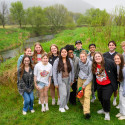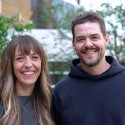Communicating danger across 10,000 years
Giant symbols carved into canyon walls might tell the story of a long-ago hunt, a creation myth, or a genocide — but because the cultures who created rock art have vanished, there is no way of discerning their exact meaning.
One day, the same will be true of our own symbols and methods of storytelling. This brings up a deeply disturbing question, with philosophical, moral, linguistic, scientific, and even artistic underpinnings: How do we warn succeeding generations about the extremely long-lived dangers of our nuclear waste sites?
Peter Galison, professor of the history of science at Harvard University, examines this dilemma in his Humanities Without Boundaries talk, “Wastelands and Wilderness,” on Thursday, March 8 at 7:30 p.m. at the Marquee Theater at Union South.
In his talk, Galison reveals that the Department of Energy’s Waste Isolation Pilot Plant near Carlsbad, N.M. stores about 3 million cubic feet of transuranic radioactive waste a half-mile below the earth’s surface, with a half-life of more than 10,000 years. Clearly, warning markers will be necessary.
Shapes might be used as warnings, but which ones? Federal authorities have brought together experts to help decide: scientists, architects, designers, linguists, even science fiction writers. Gigantic thorns, leaning spikes, massive earthworks, and grimacing gargoyles have all been considered. Also suggested: putting warnings in all the official languages of the United Nations — plus Navajo.
As “lands of defilement” and “lands of purity,” Galison says, wastelands and wilderness seem antithetical. Yet there are intersections between the two ideas. Don’t go there, is the message. But what is the mission? To preserve? To protect? To educate? And in the end, left alone for centuries, is there a chance that the defiled may become the pure?
This Humanities Without Boundaries event is followed by a 9 p.m. screening of the work-in-progress film “Nuclear Underground” (made by Galison and Harvard’s Robb Moss), about the debate over whether and how to bury nuclear waste for the long future. The film project has won a grant from the Sundance Documentary Film Program.
The talk and screening are sponsored by the Center for the Humanities, Nelson Institute for Environmental Studies and Center for Culture, History, and Environment, Robert F. & Jean E. Holtz Center for Science and Technology Studies, and Department of the History of Science.
Tags: events, humanities




